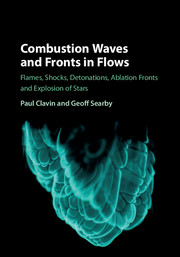 Combustion Waves and Fronts in Flows
Combustion Waves and Fronts in Flows 1 - Introduction
Published online by Cambridge University Press: 05 August 2016
Summary
Brief Historical Introduction
Fire, Humanity and Civilisation
Combustion has played a decisive role in the development of mankind and civilisation. At the present time it is the principal source of energy and the main support of economic development. Mastering the use of fire was the first major step in the development of humanity and marked a decisive step in its evolution. The oldest traces of the use of fire, limited to the occasional use of naturally occurring embers, date back to more than one million years, after the emergence of Homo erectus. However, the first fireplaces in dwellings appeared much later in Eurasia, about 450000 years ago. Neanderthal man had well mastered the art of fire, greatly improving living conditions through the ability to create light after sunset, to fight against cold, and to cook food. The first technical uses of fire were limited to hardening the points of wooden arrows and spears. Small lamps made of stone, bone or shells burning animal fat or vegetable oil, and dating back to the upper Palaeolithic 35000 years ago, can be directly associated with the development of parietal arts.
The development of other technologies using fire appeared with the advent of farming and a more sedentary existence in the Neolithic era and the early Bronze Age, some 10 000 years ago. At this time, fire was used to transform clay into pottery, and ore into metals. Because of its capacity to transform and purify(?) or destroy matter and its dancing flames, source of light and heat, fire quickly acquired a mystical dimension as attested by the central place of fire in the Vedic ritual and in the legends of antique Greece. Let us cite, for example, the legend of Prometheus, a Titan who stole fire from Zeus and gave it to the mortals, as did his Hindu counterpart, Pramatha, the hero who brought civilising fire to earth. The holders of the secrets of fire were at the same time priests and scientists, as for example the ‘Guild of Chinese Blacksmiths’ (eighth century BC), which was at the origins of Taoism at the time of Laozi (sixth century BC). From this stems the Taoist alchemy, more than one and a half millenniums before the alchemy of the Middle Ages, whose esoteric gnosis reserved a major role for the sacred fire.
- Type
- Chapter
- Information
- Combustion Waves and Fronts in FlowsFlames, Shocks, Detonations, Ablation Fronts and Explosion of Stars, pp. 1 - 10Publisher: Cambridge University PressPrint publication year: 2016
